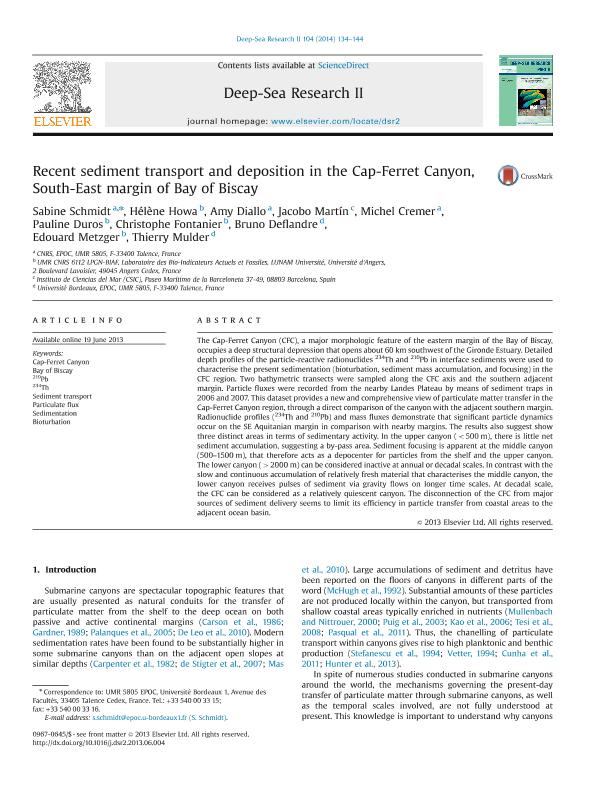Mostrar el registro sencillo del ítem
dc.contributor.author
Schmidt, Sabine
dc.contributor.author
Howa, Héléne
dc.contributor.author
Diallo, Amy
dc.contributor.author
Martín de Nascimento, Jacobo

dc.contributor.author
Cremer, Michel
dc.contributor.author
Duros, Pauline
dc.contributor.author
Fontanier, Christophe
dc.contributor.author
Deflandre, Bruno
dc.contributor.author
Metzger, Edouard
dc.contributor.author
Mulder, Thierry
dc.date.available
2016-08-01T20:47:44Z
dc.date.issued
2014-03
dc.identifier.citation
Schmidt, Sabine; Howa, Héléne; Diallo, Amy; Martín de Nascimento, Jacobo; Cremer, Michel; et al.; Recent sediment transport and deposition in the Cap-Ferret Canyon, South-East margin of Bay of Biscay; Elsevier; Deep Sea Research Part II: Topical Studies in Oceanography; 104; 3-2014; 134-144
dc.identifier.issn
0967-0645
dc.identifier.uri
http://hdl.handle.net/11336/6855
dc.description.abstract
The Cap-Ferret Canyon (CFC), a major morphologic feature of the eastern margin of the Bay of Biscay, occupies a deep structural depression that opens about 60 km southwest of the Gironde Estuary. Detailed depth profiles of the particle-reactive radionuclides 234Th and 210Pb in interface sediments were used to characterise the present sedimentation (bioturbation, sediment mass accumulation, and focusing) in the CFC region. Two bathymetric transects were sampled along the CFC axis and the southern adjacent margin. Particle fluxes were recorded from the nearby Landes Plateau by means of sediment traps in 2006 and 2007. This dataset provides a new and comprehensive view of particulate matter transfer in the Cap-Ferret Canyon region, through a direct comparison of the canyon with the adjacent southern margin. Radionuclide profiles (234Th and 210Pb) and mass fluxes demonstrate that significant particle dynamics occur on the SE Aquitanian margin in comparison with nearby margins. The results also suggest show three distinct areas in terms of sedimentary activity. In the upper canyon (<500 m), there is little net sediment accumulation, suggesting a by-pass area. Sediment focusing is apparent at the middle canyon (500–1500 m), that therefore acts as a depocenter for particles from the shelf and the upper canyon. The lower canyon (>2000 m) can be considered inactive at annual or decadal scales. In contrast with the slow and continuous accumulation of relatively fresh material that characterises the middle canyon, the lower canyon receives pulses of sediment via gravity flows on longer time scales. At decadal scale, the CFC can be considered as a relatively quiescent canyon. The disconnection of the CFC from major sources of sediment delivery seems to limit its efficiency in particle transfer from coastal areas to the adjacent ocean basin.
dc.format
application/pdf
dc.language.iso
eng
dc.publisher
Elsevier

dc.rights
info:eu-repo/semantics/openAccess
dc.rights.uri
https://creativecommons.org/licenses/by-nc-nd/2.5/ar/
dc.subject
Sediment Transport
dc.subject
Cap-Ferret Canyon
dc.subject
210pb
dc.subject
Sedimentation
dc.subject.classification
Geociencias multidisciplinaria

dc.subject.classification
Ciencias de la Tierra y relacionadas con el Medio Ambiente

dc.subject.classification
CIENCIAS NATURALES Y EXACTAS

dc.title
Recent sediment transport and deposition in the Cap-Ferret Canyon, South-East margin of Bay of Biscay
dc.type
info:eu-repo/semantics/article
dc.type
info:ar-repo/semantics/artículo
dc.type
info:eu-repo/semantics/publishedVersion
dc.date.updated
2016-08-01T18:17:22Z
dc.journal.volume
104
dc.journal.pagination
134-144
dc.journal.pais
Países Bajos

dc.journal.ciudad
Amsterdam
dc.description.fil
Fil: Schmidt, Sabine. Centre National de la Recherche Scientifique. Environnements et Paléoenvironnements Océaniques; Francia
dc.description.fil
Fil: Howa, Héléne. LUNAM Université. Laboratoire des Bio-Indicateurs Actuels et Fossiles; Francia
dc.description.fil
Fil: Diallo, Amy. Centre National de la Recherche Scientifique. Environnements et Paléoenvironnements Océaniques; Francia
dc.description.fil
Fil: Martín de Nascimento, Jacobo. Consejo Superior de Investigaciones Cientificas. Instituto de Ciencias del Mar; España. Consejo Nacional de Investigaciones Científicas y Técnicas. Centro Austral de Investigaciones Científicas; Argentina
dc.description.fil
Fil: Cremer, Michel. Centre National de la Recherche Scientifique. Environnements et Paléoenvironnements Océaniques; Francia
dc.description.fil
Fil: Duros, Pauline. LUNAM Université. Laboratoire des Bio-Indicateurs Actuels et Fossiles; Francia
dc.description.fil
Fil: Fontanier, Christophe. LUNAM Université. Laboratoire des Bio-Indicateurs Actuels et Fossiles; Francia
dc.description.fil
Fil: Deflandre, Bruno. Universite de Bordeaux; Francia
dc.description.fil
Fil: Metzger, Edouard. LUNAM Université. Laboratoire des Bio-Indicateurs Actuels et Fossiles; Francia
dc.description.fil
Fil: Mulder, Thierry. Universite de Bordeaux; Francia
dc.journal.title
Deep Sea Research Part II: Topical Studies in Oceanography

dc.relation.alternativeid
info:eu-repo/semantics/altIdentifier/url/http://www.sciencedirect.com/science/article/pii/S0967064513002348
dc.relation.alternativeid
info:eu-repo/semantics/altIdentifier/doi/10.1016/j.dsr2.2013.06.004
dc.relation.alternativeid
info:eu-repo/semantics/altIdentifier/doi/http://dx.doi.org/10.1016/j.dsr2.2013.06.004
Archivos asociados
